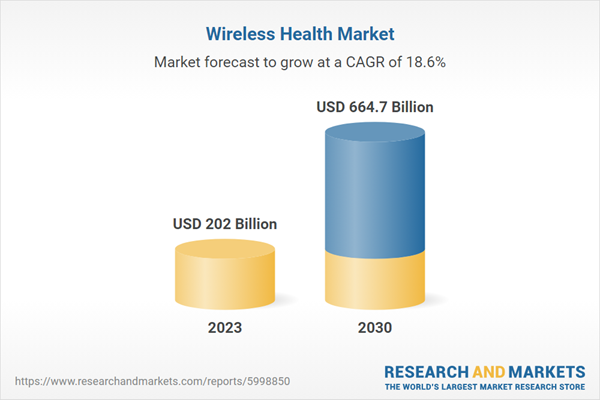Wireless Health Market Growth & Trends
The global wireless health market size is expected to reach USD 664.7 billion by 2030, exhibiting a 18.6% CAGR during the forecast period. An increase in the number of eHealth initiatives worldwide, an increase in the penetration of smartphones and Internet connectivity, and growth in the trend of self-disease management are some of the factors boosting the market growth. A growing trend toward the use of wearable devices for monitoring physical parameters, such as sleep, blood pressure, heart rate, and physical activity, is also driving the wireless health market.The growing geriatric population and subsequent rise in chronic disease burden is also driving the market. According to The Wall Street Journal, there has been an increase in the usage of digital medicine, which enables the management of chronic conditions such as diabetes, heart diseases, and respiratory diseases. Moreover, these digital medicines are cost-effective alternatives to traditional disease management.
Shifting trend toward value-based care is another factor contributing to the growth of the wireless health market. At present, some of the telehealth services, such as consulting a doctor via video connection, are reimbursed by CMS. The use of digital services such as various platforms for health management has promoted the development of various applications for managing diabetes, heart diseases, and asthma. The use of applications for chronic disease management, fitness tracking, supporting medication adherence, preventing hospital readmissions, symptom tracking, and managing mental and behavioral health are on the rise.
Wireless Health Market Report Highlights
- Wireless Personal Area Network (WPAN) emerged as the largest technology segment and Wireless Wide Area Network (WWAN) is anticipated to witness the fastest growth over the coming years
- Software emerged as the largest component segment owing to the rise in the number of research initiatives. The services segment, on the other hand, is anticipated to expand at the fastest CAGR of 19.0%
- Patient-specific applications emerged as the largest segment owing to increase in adoption and rise in research initiatives for developing them to manage individual health
- The patients/Individuals end use segment dominated the market in 2023. This segment's growth is attributed to factors such as advancements in personalized health tracking, increased adoption of remote patient monitoring, the rise of telehealth services, and improved chronic disease management solutions.
Why should you buy this report?
- Comprehensive Market Analysis: Gain detailed insights into the global market across major regions and segments.
- Competitive Landscape: Explore the market presence of key players worldwide.
- Future Trends: Discover the pivotal trends and drivers shaping the future of the global market.
- Actionable Recommendations: Utilize insights to uncover new revenue streams and guide strategic business decisions.
This report addresses:
- Market intelligence to enable effective decision-making
- Market estimates and forecasts from 2018 to 2030
- Growth opportunities and trend analyses
- Segment and regional revenue forecasts for market assessment
- Competition strategy and market share analysis
- Product innovation listing for you to stay ahead of the curve
- COVID-19's impact and how to sustain in these fast-evolving markets
This product will be delivered within 1-3 business days.
Table of Contents
Chapter 1. Methodology and Scope
Chapter 2. Executive Summary
Chapter 3. Global Wireless Health Market Variables, Trends, & Scope
Chapter 4. Global Wireless Health Market: Product Estimates & Trend Analysis
Chapter 5. Global Wireless Health Market: Component Estimates & Trend Analysis
Chapter 6. Global Wireless Health Market: Application Estimates & Trend Analysis
Chapter 7. Global Wireless Health Market: End Use Estimates & Trend Analysis
Chapter 8. Global Wireless Health Market: Regional Estimates & Trend Analysis
Chapter 9. Competitive Landscape
Companies Mentioned
- IBM
- Epic Systems Corporation
- Oracle
- OMRON Corporation
- Qualcomm Technologies, Inc
- Veradigm LLC
- Koninklijke Philips N.V.
- Stryker
- Alcatel-Lucent
Methodology

LOADING...
Table Information
| Report Attribute | Details |
|---|---|
| No. of Pages | 100 |
| Published | August 2024 |
| Forecast Period | 2023 - 2030 |
| Estimated Market Value ( USD | $ 202 Billion |
| Forecasted Market Value ( USD | $ 664.7 Billion |
| Compound Annual Growth Rate | 18.6% |
| Regions Covered | Global |
| No. of Companies Mentioned | 9 |









